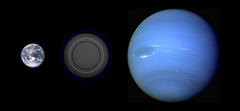Phobetor (planeta)
| ||
 Porównanie wielkości PSR B1257+12 C z Ziemią i Neptunem. | ||
| Odkrywca | Aleksander Wolszczan | |
| Data odkrycia | 9 stycznia 1992[1] | |
| Sposób odkrycia | badanie pulsara | |
| Charakterystyka orbity (J2000) | ||
| Półoś wielka | 0,47 au | |
| Mimośród | 0,0252 ± 0,0002 | |
| Okres orbitalny | 98,2114 ± 0,0002 | |
| Argument perycentrum | 108,3 ± 0,5° | |
| Czas przejścia przez perycentrum | 2 449 766,5 ± 0,1 JD | |
| Nachylenie orbity | 47 ± 3° | |
| Charakterystyka fizyczna | ||
| Masa | 3,9 ± 0,2 M⊕ | |
| Masa minimalna (M·sin i) | 0,012 ± 0,001 MJ | |
Phobetor (PSR 1257+12 C, PSR 1257+12 d) – trzecia planeta od pulsara Lich (PSR 1257+12).
Nazwa
Nazwa własna planety, Phobetor, została wyłoniona w 2015 roku w publicznym konkursie. W mitologii greckiej Fobetor był personifikacją koszmarów sennych, synem bogini nocy Nyks. Nazwy gwiazdy i okrążających ją planet zaproponowali pracownicy Planetarium Südtirol Alto Adige (Włochy)[2][3].
Charakterystyka
Planeta krąży w odległości 0,46 j.a. od centralnej gwiazdy neutronowej, a jej okres orbitalny (rok) to 98 dni. Masa planety Phobetor jest zbliżona do masy planety Poltergeist i jest około czterokrotnie większa od masy Ziemi.
Zobacz też
- Draugr (PSR 1257+12 A)
- Poltergeist (PSR 1257+12 B)
- PSR 1257+12 D
Przypisy
- ↑ Aleksander Wolszczan, Dale A. Frail: A planetary system around the millisecond pulsar PSR1257 + 12 (ang.). 1992-01-09. [dostęp 2012-11-09].
- ↑ Final Results of NameExoWorlds Public Vote Released. Międzynarodowa Unia Astronomiczna, 2015-12-15. [dostęp 2015-12-16].
- ↑ The Approved Names. W: NameExoWorlds [on-line]. Międzynarodowa Unia Astronomiczna / Zooniverse, 2015-12-15. [dostęp 2015-12-16].
Linki zewnętrzne
- Phobetor w serwisie The Extrasolar Planets Encyclopaedia (ang.)
Media użyte na tej stronie
Autor: Aldaron, a.k.a. Aldaron, Licencja: CC BY-SA 3.0
Comparison of several possible sizes for the exoplanet PSR B1257+12 C with the Solar System planets Earth and Neptune, using approximate models of planetary radius as a function of mass[1] for several possible compositions, based on mass reported in the Open Exoplanet Catalogue[2] as of 2015-11-14. Models include:
PSR B1257+12 C is not likely to be smaller than the iron planet, and will be considerably larger than the water planet if significant H or He is present. For non-transiting planets, all modeled sizes will be underestimates to the extent that the planet's actual mass is larger than the reported minimum mass.
- ↑ Seager, S.; M. Kuchner, C. A. Hier-Majumder and B. Militzer (2007). "Mass–radius relationships for solid exoplanets". The Astrophysical Journal 669: 1279–1297. DOI:10.1086/521346. Retrieved on 2015-11-14.
- ↑ Open Exoplanet Catalogue (2015-11-14). Retrieved on 2015-11-14.
